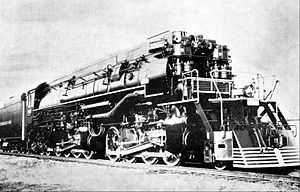Southern Pacific class AC-9
| Southern Pacific AC-9 | |
|---|---|
 | |
| Type and origin | |
| Power type | Steam |
| Builder | Lima Locomotive Works |
| Serial number | 7765–7776 |
| Build date | 1939 |
| Total produced | 12 |
| Specifications | |
| Configuration | 2-8-8-4 |
| UIC classification | (1′D)D2′ h4 |
| Gauge | 4 ft 8 1⁄2 in (1,435 mm) |
| Driver diameter | 63 1⁄2 in (1,613 mm) |
| Axle load | 66,400 lb (30.1 tonnes) |
| Weight on drivers | 522,200 lb (236.9 tonnes) |
| Locomotive weight | 677,200 lb (307.2 tonnes) |
| Locomotive and tender combined weight | 998,000 lb (453 t) |
| Fuel type | Coal |
| Fuel capacity | 28 short tons (25 t; 25 long tons) |
| Water capacity | 22,100 US gallons (84,000 l; 18,400 imp gal) |
| Boiler pressure | 250 psi (1.72 MPa) |
| Firegrate area | 139.5 sq ft (12.96 m2) |
| Heating surface: – Total | 6,918 sq ft (642.7 m2) |
| Superheater area | 2,831 sq ft (263.0 m2) |
| Cylinders | Four (simple articulated) |
| Cylinder size | 24 in × 32 in (610 mm × 813 mm) |
| Valve gear | Walschaerts |
| Performance figures | |
| Tractive effort | 123,364 lbf (548.75 kN) |
| Career | |
| Operator(s) | Southern Pacific Company |
| Class | AC-9 |
| Number(s) | 3800–3811 |
| Disposition | All scrapped |
The AC-9 was one of two Southern Pacific Railroad's articulated steam locomotive class that ran with a forward smokebox after 1920 (The other articulated locomotives fall into the cab-forward design). Twelve AC-9 class locomotives were built by Lima in 1939 and were Southern Pacific's largest and heaviest steam engines, partly a consequence of low quality coal the engines were designed to burn. The AC-9s were partially streamlined (the only articulated steam engines to be so equipped), having "skyline casings" inspired by Lima's GS series of 4-8-4's, also made for Southern Pacific, and were equipped with coal tenders, unlike cab forwards. Their wheel arrangement was 2-8-8-4, which was nicknamed "Yellowstone". Between 1939 and 1952, all the twelve AC-9 engines were in service between Tucumcari, New Mexico, El Paso, Texas, and Tucson, Arizona, where they mainly pulled freight trains and occasionally also passenger trains such as the Golden State Limited. In 1952, they were converted to burn oil instead of coal, and moved to Southern Pacific's Modoc line between Sparks, Nevada, and Alturas, California, where they worked in freight service from 1953 until retirement in 1956.
No AC-9 engine has been preserved.
External links
| ||||||||||||||||||